#ic markets islamic
Explore tagged Tumblr posts
Text
untuk hari bahasa ini, saya cubalah mengajarkan semua tentang sikit budaya melayu dan berkongsi kosa kata juga (ENG TRANSLATION)
(for this language day, I will try to teach a little about Malay culture and share vocabulary as well)
i made the original post detailing some fun stuff abt my culture of being malay (specifically from perspective living as a Malay from Singapore), i want to do an english translation so its more accessible to those who don't speak malay. This isnt an exact translation (plus im adding mroe additonal info) so keep that inmind
FIRST, what is the Malay language? This is an Austronesian language, also the national language in Brunei, Malaysia and Singapore. Malay is usually written in Latin script, also known as Rumi. There is also Jawi script based on Arabic writing. If you want to know (most) letters in Jawi, this is a video stuck in my head from Andalus (I'm bad at writing in Jawi and Arabic too, even though I study, I don't know much;;;)
Malay culture is deeply connected with Muslim culture, that's why a lot of malay festivities and celebrations revolve around the islamic calender. one such celebration is Hari Raya. there are two ceremonies; Aidilfitri and Haji, I will talk about Hari Raya Aidilfitri only because it is close this year and most well known (for context, its litterally in april this year).
The previous month is Ramadan where we fast/puasa. We do not eat from Subuh (around sunrise) to Maghrib (around sunset) (these are two of the names of the prayer times, in Islam we are supposed to pray around 5 times a day during different intervals. it goes Subuh, Zohor, Asar, Maghrib, Isyak). Before dawn, want to eat Sahur and then pray. At Maghrib, want to eat to break the fast/ berbuka puasa (usually say "buka" for short). Also in this month before Aidifilti, the family will prepare by cleaning the house for visitors, buy new baju kurung, get kuih, etc etc.
aaaa there are a lot of kuih, here's anything I can name (many are from Singapore); kuih lapis, kuih salat? ondeh ondeh, kuih bahulu, kuih dadar, BISKUT CORNFLAKES OMG does that count?. there are many more lol.
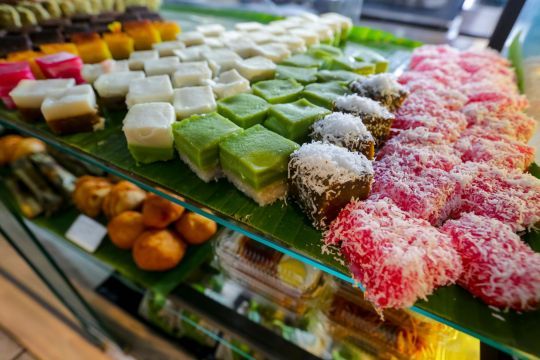
ALSO! In Singapore, during Ramadan, there is a huge Night Market in Geylang. Not only in Geylang there is a night market but this is very popular. There are MANY stalls selling food. Everyone who buys from geylang night market knows Ramly Burger, deep-fried Oreos, vadai, KEBAB, DENGDENG. (I like to buy rolled ice cream and chicken kebab mmmm)
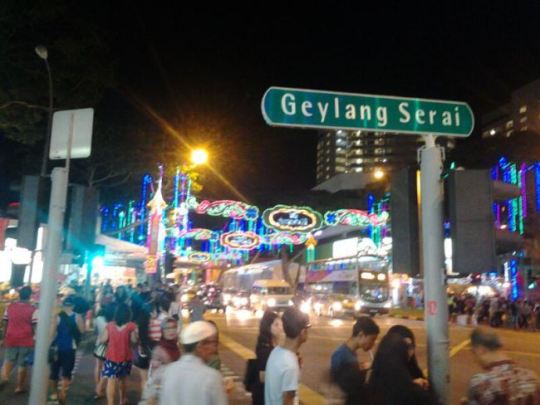
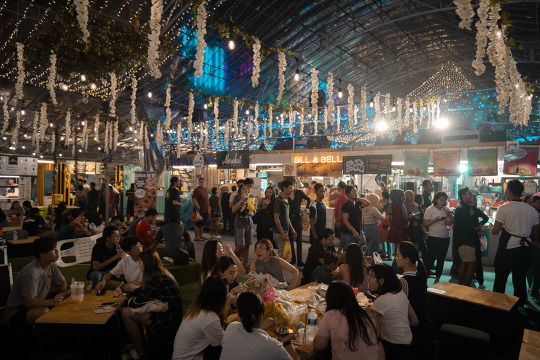
In Geylang too, they will buy traditional clothes to visit family. Baju kurung (ehh for traditional clothes, women wear baju kurung, men wear baju melayu but the names are the same anyway) is the normal clothing. Often, one household will choose to coordinate colors together (but it's not mandatory, lmao my family doesn't care)
For men, they wear songkok (that flat black hat) and samping (the long scarf wrapping around the waist)
For women, wear a sarong (skirt) with a long top. If desired, will also wear a tudung (type of hijab) (i should also clarify for muslim women its their choice whether they want to habitually wear hijab. its not just specific to just baju kurung. for example i have lots of aunties that dont wear hijab at all meanwhile i have a lot of aunts who do)

Baju kurung is also worn at other festivities, such as weddings


(my whole childhood I attended so many weddings, this is another topic lmaooooo)
On Hari Raya Aidifilti but before going to raya (this is what we generally call going out to see family), close family in will ask for forgiveness. (it's important the forgiveness is not one-sided, the adults will also ask forgiveness from the younger family members too). Usually this is when people start crying. After that, we go RAYA!!! When in someone else's house, if you are not working now, you can get duit raya! (because I grew up in singapore surrounded by chinese influence, I also call this "angpao" too)
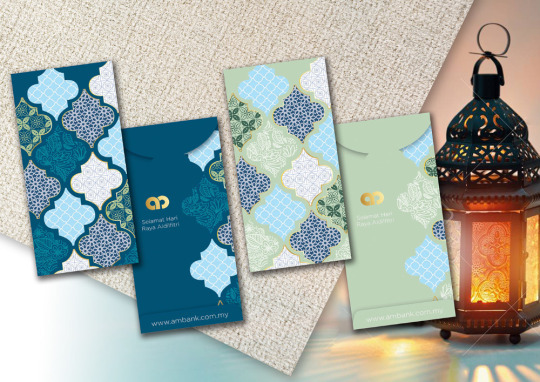
OHHHH THERE IS A LOT OF FOOD;;;; My grandmother would cook a lot during Ramadan and Hari Raya. Rendang, lontong, KETUPAT OHHH KETUPAT, CHICKEN CURRY (my mother every aidifitri cooks green chicken curry, FOR HARI RAYA AIDIFITRI ONLY, ohhhhh that's my favorite part, ASBFKASB I'M HUNGRY.)

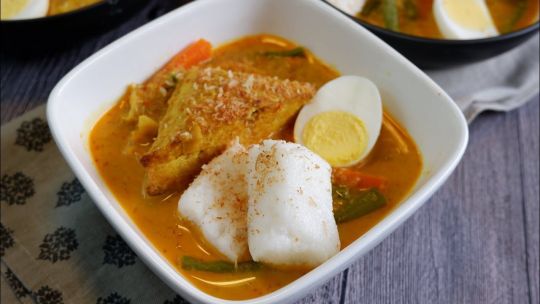
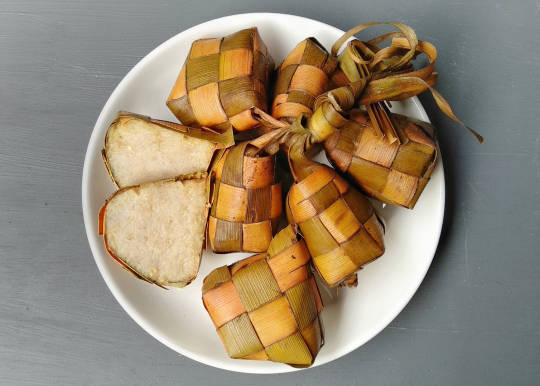

(theres also like way more cuisine than this, iu havent even mentioned nasi goreng and nasi lemak and briyani and FUCKIGN BEGEDIL;;;;)
ketupat is kind of icon to represent Aidifilti holiday, for example:

other icons of hari raya include: bunga api, neon string lights, bamboo torches, etc.
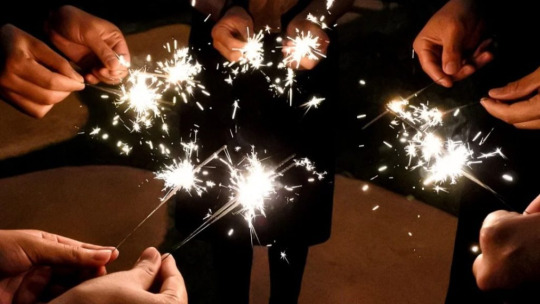
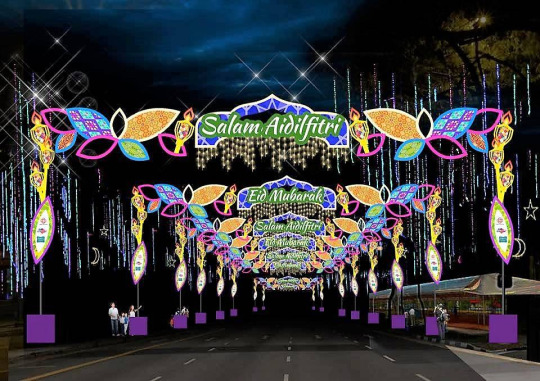

I love Hari Raya even thoug my feet hurt ALOT after visiting LOTS OF FAMILY AND FRIENDS OH MY GOD:;; it's okay if you take your shoes off in the house somehow your FEET WILL HURT at the end of the day;;;;;;
uhhhh others about malay culture? we have art! A martial art is silat melayu! I don't know much about this but it's great
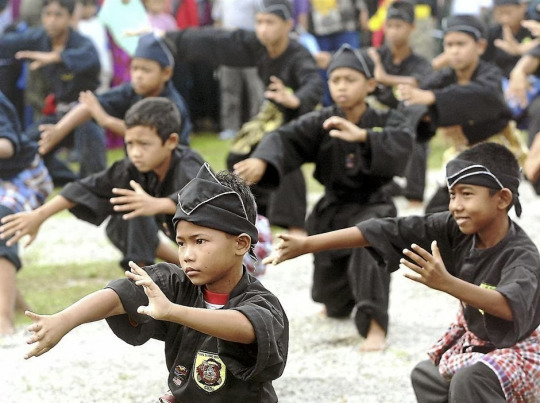
there is performance art: one example is dikir barat
youtube
juga ada permainan, ada yang terkenal ialah wau (kite)
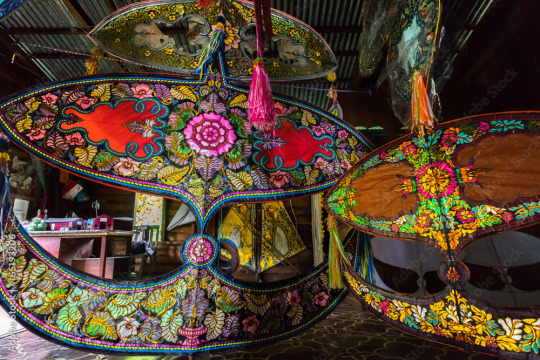
and congkak (like that one club penguin game, mancala, im not kidding)
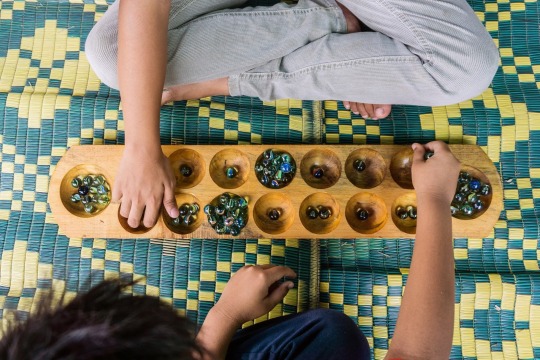

there are many malay cultures that are also from indonesian culture because of its influence. (Mainly malay culture was influenced by its neighboring cultures such as from Thailand, Sumatra, Java. Malay culture were from Hinduism before then converting to Islam) That's why we have wayang kulit (natively from Java) (a lot of indonesian culture and malay cultures share similar things because of kinda their similar roots and their spread of their own culture, hence why we also have similar dishes, traditonal clothes, even our language is kinda 70% the same)

Do you know; Singapore was discovered by Sang Nila Utama and was originally Malay kingdom (at that time the island was called Temasek before it was owned by the British) (the original indigenous of Singapore are called Orang Laut, litterally translated to "people of the sea"). That is why in Singapore, the language and the national anthem (Majulah Singapura) is in Malay. Singapore is not only for Chinese people, we Malays and Indians are also here;;;
(and im not at all from malaysia god please none of my relatives are. Malaysian is referring to the country, Malay is the language and the ethnic group)
There's a whole lot more I haven't even touched on, like lmao there's a whole thing about weddings and a whole baby shower thing.
theres also a lot of singaporean stuff i want to share i haven't even mentioned singlish but thats a post for another time
58 notes
·
View notes
Note
hello! Im visiting Copenhagen in January and was wondering if you have any recommendations of things to do or like cafes/stores/etc to visit?
Hi nonnie! So sorry for the delayed answer, I was down with the flu/plague/?? most of december so I've only just gotten back to my inbox.
I've tried to make a compilation of the recommendations for places to see, eat, and shop that aren't just the usual touristy stuff. I hope you enjoy your trip and the weather won't be too Copenhagen-in-January!
Where to eat (especially bakeries)
Sct. Peders Bageri – The oldest bakery in Denmark! They have a wonderful selection of traditional Danish baked goods but their seasonal varieties are also incredible.
BUKA – They have a few bakeries in town now and some of the best croissants and pastries.
Cakery Copenhagen – The best eclairs in town, hands down. Always a bunch of fun seasonal varieties and mini versions.
Bertels Salon – They do cheesecakes. And they’re amazing. They have 10+ fresh varieties every day (!) and turned me into a cheesecake lover.
La Glace – They do traditional Danish layer cakes and fancy patisseries as well as hot chocolate ad libitum. Very atmospheric and historic. A bit more expensive all in all but not insanely so.
Torvehallerne – Two large greenhouses full of delicious food and other food/drink related stores. Coffee Collective for coffee, Rørt for Danish smørrebrød, Granny’s House for pastries and Ma Poule for their famous duck sandwich.
Broens Gadekøkken – A small street food market right by the bridge across from Nyhavn. Depending on when you’re here, there’s also an ice skating rink set up during winter.
Mahalle - Lebanese fusion kitchen at affordable prices. You might want to book a table just in case.
Jagger - Burgers! Not the most hyggelige surroundings (a bit too industrial chic) but you can't argue with the food. Highly recommend the milkshakes!
What to see
Glyptoteket – Absolutely gorgeous museum. Free entrance on the last Wednesday of the month.
Thorvaldsens Museum – Also stunning, focused on statues. Free entrance all Wednesdays.
Nationalmuseet – Bog bodies! Their seasonal exhibitions are usually very good.
David’s samling – Smaller museum with free entrance. Classical European and Islamic art.
Kronborg – AKA Hamlet’s castle. Technically outside Copenhagen but you can easily take the train the whole way. I highly recommend doing one of the daily guided tours (no additional cost to the entrance fee).
Rundetårn – A fun look into the old astrology tower with a lovely view of the city. The majority of the inside is one big ramp with some narrow stairs at the end so keep that in mind if you have trouble walking.
Assistentens Kirkegård digital guided tour – If the weather is with you, you can go for a digitally guided tour in the old graveyard, located in a park in the middle of the city. Here’s a link for the app.
Other nice parks in case it's not raining the whole time (Danes love going for a walk, what can I say) include the Botanical Garden, Frederiksberg Have (where you can peek into the elephant enclosure in the zoo) and Kongens Have.
To shop
Vintage shopping: There’s a bunch of good quality vintage stores on Studiestræde and Larsbjørnsensstræde. Also worth a mention is Audrey Vintage on Hyskenstræde, run by a woman who handpicks all the items from all around Europe.
Strøget is the place for high street shopping but I definitely recommend having a look around the inner city’s side streets and down Frederiksborggade (check out the home goods store Maduro here) over the lakes to Nørrebro where you’ll also find some more offbeat stores and great bars and restaurants.
The largest bookstore is Arnold Busck on Købmagergade for books in both Danish and English. Fiolstræde close by has the independent book café Brøg that I highly recommend both for books and for a quick cake + coffee. On Fiolstræde you’ll also find some used bookstores with a variety of options and other smaller shops and cafés.
20 notes
·
View notes
Text
Seeking romantasy recs? I think?
Related to something I reblogged yesterday about romantasy (a word that still makes me twitch for some reason, but whatever). I just wanted to state for the record that I really did attempt to read Sarah J. Maas' Throne of Glass and Jennifer Armentrout's Blood & Ash while the kids had their winter vacation last week, and somehow neither of them clicked for me. (Instead, I ended up devouring @qqueenofhades' full catalogue of Old Guard fanfic and I regret nothing.)
But, let me be clear, I find this frustrating! Everything about romantasy on the surface is 100% My Jam, and there is so much of it that I desperately want to get in on this trend. I spent my childhood and adolescence reading Caroline Cooney, Lois Duncan, Francesca Lia Block, Terry Windling/Ellen Datlow anthologies, Tanith Lee, and eventually Jacqueline Carey--all authors who would probably be categorized as romantasy today. I'm willing to bet that the current crop of bestselling authors read a lot of the same books and were similarly delighted.
Carey, in particular, does the complicated court intrigue with just a hint of fantasy really well. She may have spoiled me--and maybe it's because her books were explicitly written and marketed as adult fantasy. Not YA. Shelved alongside A Song of Ice and Fire and The Wheel of Time. They're not much longer than the YA romantasy I'm seeing these days, but they are denser, more complicated, and the first-person narrator is always deeply unreliable.
I'm not saying these books are flawless, not by a long shot. I reread Kushiel's Dart for the first time in ages last year, and it is a very white* and largely cis- and hetero-normative book, in spite of the fact that the main character is a sex worker and is obviously bisexual. And there are legitimate gripes with how fictional versions of certain religions (particularly Judaism, not to mention the lack of Islam altogether**) are depicted in later books. But what I do appreciate about them is that they tell a damn good story. Even when I don't agree with the worldbuilding choices, they generally hang together, and it's a fun version of the "Renaissance Europe but not quite" universe. She's willing to try unusual things, and they're always interesting to read even if they don't always work.
So, does anyone have any recs for current romantasy that's comparable to Jacqueline Carey? Was I just reading the wrong Maas series, and should I give ACOTAR a try? I can always just reread the rest of the Kushiel books if that's the only thing that will work, but I'd love to try something new!
* What prompted me to read Kushiel's Dart in the first place was the description of its protagonist as a girl with extremely dark brown eyes and a red birthmark in one. I happen to have both of those things, so I just assumed she was as dark as me until some point later in the book when the whiteness of her skin was commented on. I wasn't surprised, only disappointed.
** This, I suspect, has a lot to do with the fact that the books were published between 2001 and 2003 in the United States. Ahem.
#romantasy#romance books#fantasy romance#jacqueline carey#sarah j maas#jennifer armentrout#books#book recs#looking for book recs
2 notes
·
View notes
Text
Jewish refugees are begrudged that little sliver of refuge called Israel
By bataween on 14 December 2023
With the rise of antisemitism, Jewish refugees from Iran who found refuge in the USA now worry that they might have to uproot themselves once again. Alex Abel tells one’s family’s story in Jew in the City:

Hebrew version of the 12th century Persian poet Nizami Ganjani’s “Khosrow va Shirin”.
In all this talk about the Jews “colonizing” Israel, so many don’t even know that Israel was the place Jews had to go to because they were kicked out of somewhere else. It wasn’t just a fun mission of conquering a land (which by the way is completely indigenous to the Jews), it was a place of refuge. For some, it was refuge after the Holocaust. For others, it was there when they were actually kicked out of all the other Arab lands around them.
Israel represents a little sliver of hope, freedom and simply existence for the Jewish people. That’s why it’s so infuriating that the world doesn’t even want to allow us that much.
Today, November 30, is the day the Israeli Knesset actually adopted as a national day of commemoration for the 850,000 Jewish refugees who were displaced from Arab countries and Iran in the 20th century.
Jews lived in Arab lands for thousands of years and many of their communities were actually there before the advent of Islam. In the 20th century, Arab nationalism rose around them and it was no longer safe to be a Jew in many of these places.
According to the Israeli government, “Arab states expropriated property of their native Jews, and denaturalized, expelled, arrested, tortured and murdered many of them.”
Ariel Homapour (who goes by Ariel Laurent now) knows this story well. His mother and father left Iran and Pakistan, respectively, after experiencing fear and oppression there. Ariel himself is the eldest child in his family and the first born outside of Iran in the last thousand years of his family’s history.
His father, Morris, left when he was just 16 years old in 1987. At that age, you could be drafted into the military in Pakistan. Laurent says they didn’t have time to actually train the teenagers taken into the army and even with that, would just take them straight to the frontlines right away and naturally, many were killed right away.
Ariel’s grandmother hid his father in an underground cellar for six months so he wouldn’t be drafted. After that, they paid someone who was driving a caravan to Iraq to smuggle him out (which was a common practice at the time). The first person they paid actually stole their money and left. The second worked out though and so Morris was driven covertly across the border.
Once they got there, they were getting shot at by the Islamic regime. He ran the rest of the way.
In Baghdad, there was no clean, running water. It was muddy, with worms coming out of it. He knew if he drank that water he would get very sick so lived off of Coca Cola for 5-6 weeks. From there, he took a flight to Vienna, Austria where he waited for a few months before he could get into the United States. He survived in Vienna by shoveling ice to make money.
When he got to America, he stayed with his uncle in Queens. He worked at a flea market selling random odds and ends and helped in the jewelry business. Eventually, he saved enough money to open a woman’s clothing store called High Image. It initially had just five to six items in the whole store. He grew this business to two different locations — in Brooklyn and Long Island that existed until right before Covid.
“He never really had a childhood,” Ariel shares. “He had to grow up really fast and always had to work hard. He never really had anybody to lean on. That’s the trauma of war, it’s really hard.”
Morris’s family in Iran owned many dry cleaning locations which were all pretty much taken away from them. The rest of his family stayed there until 2001 when they moved to Israel. It wasn’t until that year that Morris saw the rest of his family again — more than 20 years.
Ariel’s mother got to leave with her family, but didn’t know she was leaving for good until they never looked back.
They went to Israel from Iran to visit a sick relative but were planning to come back. Then, they didn’t. The revolution in Iran was getting so bad and being Jewish was such a fear, they decided to stay. They went back one time two years later to gather some of their personal belongings, but weren’t able to take all of it because so much had been seized by the government.
That was in 1978, when his mother was ten-years-old. She also demonstrated immense resilience amid the struggle to start over. In Israel, she was bullied because she couldn’t speak the language. When she was 12, in 1980, her family moved to America and she had to learn yet another new way to speak.
While the mountain felt almost too high to climb, she did it gracefully. She learned English, went to high school and college in America, grew to the top of her class and became a CPA.
His parents met each other when they were 26 at a wedding in New York.
Ariel’s parents made sure to keep their heritage alive in the next generation. Ariel and his two younger siblings speak Farsi. “They made sure I didn’t lose the Persian language,” he says. He grew up in Roslyn and didn’t learn English until he went to Kindergarten.
Now, his parents are having flashbacks to having to uproot their entire lives. With the rising antisemitism in the U.S., they’re scared. “They always say how much they sacrificed to get here,” he says. “It was always a land of refuge. It’s very traumatic for them with the rise of antisemitism.”
Read article in full
16 notes
·
View notes
Text
Events 11.17 (after 1950)
1950 – Lhamo Dondrub is officially named the 14th Dalai Lama. 1950 – United Nations Security Council Resolution 89 relating to the Palestine Question is adopted. 1953 – The remaining human inhabitants of the Blasket Islands, Kerry, Ireland, are evacuated to the mainland. 1957 – Vickers Viscount G-AOHP of British European Airways crashes at Ballerup after the failure of three engines on approach to Copenhagen Airport. The cause is a malfunction of the anti-icing system on the aircraft. There are no fatalities. 1962 – President John F. Kennedy dedicates Washington Dulles International Airport, serving the Washington, D.C., region. 1967 – Vietnam War: Acting on optimistic reports that he had been given on November 13, U.S. President Lyndon B. Johnson tells the nation that, while much remained to be done, "We are inflicting greater losses than we're taking…We are making progress." 1968 – British European Airways introduces the BAC One-Eleven into commercial service. 1968 – Viewers of the Raiders–Jets football game in the eastern United States are denied the opportunity to watch its exciting finish when NBC broadcasts Heidi instead, prompting changes to sports broadcasting in the U.S. 1969 – Cold War: Negotiators from the Soviet Union and the United States meet in Helsinki, Finland to begin SALT I negotiations aimed at limiting the number of strategic weapons on both sides. 1970 – Vietnam War: Lieutenant William Calley goes on trial for the My Lai Massacre. 1970 – Luna programme: The Soviet Union lands Lunokhod 1 on Mare Imbrium (Sea of Rains) on the Moon. This is the first roving remote-controlled robot to land on another world and is released by the orbiting Luna 17 spacecraft. 1973 – Watergate scandal: In Orlando, Florida, U.S. President Richard Nixon tells 400 Associated Press managing editors "I am not a crook." 1973 – The Athens Polytechnic uprising against the military regime ends in a bloodshed in the Greek capital. 1983 – The Zapatista Army of National Liberation is founded in Mexico. 1986 – The flight crew of Japan Airlines Flight 1628 are involved in a UFO sighting incident while flying over Alaska. 1989 – Cold War: Velvet Revolution begins: In Czechoslovakia, a student demonstration in Prague is quelled by riot police. This sparks an uprising aimed at overthrowing the communist government (it succeeds on December 29). 1990 – Fugendake, part of the Mount Unzen volcanic complex, Nagasaki Prefecture, Japan, becomes active again and erupts. 1993 – United States House of Representatives passes a resolution to establish the North American Free Trade Agreement. 1993 – In Nigeria, General Sani Abacha ousts the government of Ernest Shonekan in a military coup. 1997 – In Luxor, Egypt, 62 people are killed by six Islamic militants outside the Temple of Hatshepsut, known as Luxor massacre. 2000 – A catastrophic landslide in Log pod Mangartom, Slovenia, kills seven, and causes millions of SIT of damage. It is one of the worst catastrophes in Slovenia in the past 100 years. 2000 – Alberto Fujimori is removed from office as president of Peru. 2003 – Actor Arnold Schwarzenegger’s tenure as the governor of California began. 2012 – At least 50 schoolchildren are killed in an accident at a railway crossing near Manfalut, Egypt. 2013 – Fifty people are killed when Tatarstan Airlines Flight 363 crashes at Kazan Airport, Russia. 2013 – A rare late-season tornado outbreak strikes the Midwest. Illinois and Indiana are most affected with tornado reports as far north as lower Michigan. In all around six dozen tornadoes touch down in approximately an 11-hour time period, including seven EF3 and two EF4 tornadoes. 2019 – The first known case of COVID-19 is traced to a 55-year-old man who had visited a market in Wuhan, Hubei Province, China.
2 notes
·
View notes
Text
A Peaceful Escape: Why Navsari Is Gujarat’s Hidden Gem
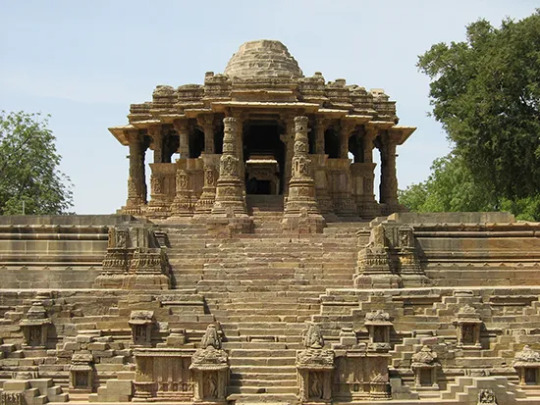
In a state filled with bustling metropolises and well-known tourist circuits, Navsari quietly stands apart as Gujarat’s hidden gem—a place where serenity, heritage, and local culture converge in perfect harmony. Often overlooked in favor of cities like Surat or Vadodara, Navsari offers travelers an authentic and peaceful experience, steeped in timeless traditions and untouched charm.
Whether you’re in search of spiritual solace, a journey through Parsi history, or simply looking to slow down and soak in small-town life, Navsari delivers more than expected. Here’s why this tranquil destination deserves a spot on your Gujarat itinerary.
A Town Steeped in Time and Heritage
Navsari holds a special place in India’s cultural map—not only for being a major center of Parsi Zoroastrian heritage but also for its gentle blend of colonial architecture, ancient temples, and leafy boulevards. With its roots tracing back over a thousand years, Navsari has grown gracefully, preserving its essence while adapting to the present.
You won’t find flashy malls or buzzing nightlife here. Instead, Navsari invites you to explore Best Resort in Navsari, heritage homes, chat with local artisans, and discover stories carved in stone and whispered through generations.
A Cradle of Parsi Culture
Perhaps Navsari’s most defining cultural legacy is its role as a spiritual and educational hub for the Parsi community. In fact, it is often referred to as the Dharampur (religious city) for Zoroastrians in India.
One of the town’s most sacred landmarks is the Sanjanwala Atash Behram, a Parsi fire temple that houses a holy flame that has been burning for centuries. Though non-Parsis cannot enter, the temple’s presence adds an air of mysticism to the city, reflecting a deeply spiritual heartbeat.
Nearby, the Meherjirana Library, established in 1872, preserves ancient Zoroastrian texts and manuscripts. It’s one of the oldest libraries of its kind and a haven for researchers and scholars from around the world.
Architecture That Whispers of the Past
Walk through Navsari’s inner streets and you’ll come across wooden homes with ornate balconies, grand Parsi baugs (colonial-style housing estates), and vintage lamp posts lining the sidewalks. Many of these structures date back to the British era and reflect a unique fusion of European and Gujarati design.
The Tower Road area is particularly rich in historic buildings. A slow stroll here is like walking through a living museum—complete with quiet corners, neighborhood grocers, and hand-painted signs that haven’t changed in decades.
Spiritual Diversity and Harmony
What makes Navsari truly special is the peaceful coexistence of different religious traditions. Hindu temples, Jain derasars, Islamic mosques, and Christian churches dot the city’s landscape. It’s not uncommon to hear temple bells and the azan echoing across the town in unison.
Among the many temples, the Dudhia Talao Temple and Trimandir are prominent. These places offer not just religious significance but also a serene setting for meditation and reflection, often visited by locals and spiritual seekers alike.
A Taste of Local Life
Best Restaurants in Navsari is rich in flavor. From Parsi dhansak and lagan nu custard to local Gujarati thalis and sweet treats like sutarfeni and ghari, every bite tells a story. Don’t forget to try the famous Navsari ice halwa, a local delicacy sold in tiny family-run shops that have been in business for generations.
The city also has a strong agricultural tradition, with fresh produce markets bursting with color and community spirit. A morning walk through the Navsari vegetable market is an experience in itself—vibrant, aromatic, and full of friendly faces.
Nature and Tranquility on the Coast
Navsari is just a short drive away from Gujarat’s scenic coastline. Beaches like Dandi, historically significant due to Mahatma Gandhi’s Salt March, offer an ideal day trip. You can also visit Jalalpore, a peaceful riverside area perfect for unwinding amidst nature.
For bird watchers and nature lovers, the Vansda National Park, about an hour away, offers a taste of Gujarat’s wilderness with dense forests, waterfalls, and wildlife including leopards, hyenas, and a variety of bird species.
Festivals That Reflect Harmony
Navsari’s festivals reflect its diverse yet united soul. Navroze (Parsi New Year) is celebrated with much fervor, while Navratri, Diwali, and Eid bring the town together in joyous celebration. The town’s peaceful vibe is amplified during these times, as communities share meals, stories, and smiles.
A Refreshing Alternative for Mindful Travel
In an era of fast-paced tourism, Navsari offers a rare opportunity for mindful and meaningful travel. Whether you’re a cultural explorer, history buff, spiritual seeker, or someone simply looking to unwind, Navsari provides the perfect slow-travel experience.
Final Thoughts
Navsari is not a place you rush through. It’s a town you listen to. You sit on its quiet benches, sip chai in its ancient courtyards, and let the gentle rhythm of local life soothe your soul. It’s where stories are not just told—they’re lived.
If you’re planning your next trip through Gujarat and want something more than the usual sights and sounds, give Navsari a chance. You may find, in its peaceful alleys and welcoming smiles, a part of India you didn’t know you were missing.
0 notes
Text
What's the Deal with Gelatin? Understanding Food Thickeners and Their Alternatives
Ever wondered what makes your jello jiggly, your gummy bears chewy, or your yogurt creamy? The answer is often gelatin—a unique food ingredient with special properties that food scientists have been trying to replicate for years. But what exactly is gelatin, and why are so many companies looking for alternatives? Let's dive in!

What is Gelatin, Anyway?
Gelatin is a protein that comes from animal sources—mainly pigskin, cattle bones, and cattle hide. It's used in tons of everyday foods like:
Desserts and jellies
Yogurt and cream cheese
Marshmallows and gummy candies
Ice cream
Fruit toppings for pastries
Gravies and soups
Even as clarifiers in juices and beer!
What makes gelatin special is its ability to form a gel that melts in your mouth. When you eat foods containing gelatin, they literally melt at body temperature (below 95°F/35°C), releasing flavor and giving that distinctive smooth texture we all know.
Why Look for Alternatives?

So if gelatin works so well, why are food companies searching for alternatives? There are several good reasons:
Religious and dietary preferences: Many people follow dietary restrictions that prohibit consuming animal products. Muslims and Jews may avoid pork-derived gelatin, while vegetarians, vegans, and Hindus may avoid all animal-sourced ingredients altogether.
Market opportunities: The halal food market (food permitted under Islamic law) is growing rapidly and is projected to represent about 30% of the global population by 2025. That's a huge market!
Health concerns: Though less of an issue now, concerns about BSE (commonly known as "mad cow disease") in the 1980s and early 2000s prompted many companies to look for plant-based alternatives.
What Makes Gelatin Hard to Replace?

Food scientists face several challenges when trying to replace gelatin because it has some truly unique properties:
Melt-in-mouth feeling: Gelatin melts right at body temperature, creating that distinctive texture that releases flavor intensely.
Thermoreversible gel: Unlike many other thickeners, gelatin can be melted and re-solidified multiple times.
Surface activity: Gelatin can help stabilize foams (like in marshmallows) and emulsions.
Ease of use: It works well in a wide range of pH levels found in foods without needing additional ingredients.
The Hunt for Alternatives

Here are some of the most promising gelatin alternatives being developed:
Fish Gelatin
Fish gelatin comes from fish skin, bones, and fins. It's generally acceptable for Muslims and, with some restrictions, for people following kosher diets. The main difference from mammalian gelatin is that fish gelatin—especially from coldwater fish like cod—melts and sets at much lower temperatures.
Some advantages of fish gelatin:
Enhanced flavor release in some products due to faster melting
Rated superior in some blind taste tests
Good for refrigerated products
Challenges include inconsistent quality between different fish species and some stability issues.
Modified Starches
Scientists have developed modified starches that form thermoreversible gels similar to gelatin. Using enzymes, they can create starch products that form strong, white gels with some gelatin-like properties. The downside? These gels typically melt at higher temperatures (around 140°F/60°C rather than body temperature) and don't have quite the same mouthfeel.
Plant-Based Hydrocolloid Blends
"Hydrocolloid" is just a fancy term for substances that form gels or thickeners in water. Plant-based options include:
Pectin blends: Combining different types of pectin (a substance found in fruits) can create gels with controlled properties.
Carrageenan: Extracted from red seaweed, carrageenan can create gels with different textures and is being used in some gummy candies.
Xanthan gum and locust bean gum combinations: These plant-derived ingredients don't work well alone but create strong gels when combined.
Gellan gum: This fermented ingredient can produce soft, elastic gels for applications like desserts and jams.
The Future of Gelatin Alternatives
Some exciting developments on the horizon include:
Cross-linking technologies: Using enzymes or plant compounds to strengthen fish gelatin and improve its properties.
Engineered plant proteins: Using genetic engineering to create plant-based proteins with gelatin-like properties.
Recombinant gelatin: Producing gelatin-like proteins using yeast or even corn plants, without any animal sources.
The Bottom Line

Gelatin remains a uniquely functional ingredient that's difficult to replace with a single alternative. The most successful approach seems to be finding specific replacements for specific applications—what works for gummy bears might not work for yogurt.
For now, food companies continue to develop creative solutions using combinations of plant-based ingredients, creating new options for consumers with different dietary preferences. So whether you enjoy traditional gelatin-based treats or prefer plant-based alternatives, food science is working to give you more delicious options than ever before.
Next time you enjoy that jiggly dessert or chewy candy, you'll know a bit more about the science that makes it possible!
0 notes
Text
Raqami Islamic Digital Bank Jobs February 2025
Raqami Islamic Digital Bank Jobs February 2025: Organization: Raqami Islamic Digital Bank We are looking for the following positions at Raqami Islamic Digital Bank. Unit Head – Market, Liquidity & Capital Risk Manager Model Risk, Strategic & Reputational Risk Unit Head – Environmental and Social Risk Management Unit Head – Technology & ICS Risk Do you have what it takes to lead change? Apply…
0 notes
Text
IC Markets Rebate, forexrebatehub.com
IC Markets Rebate
Rebate Rate: cTrader $0.5, Raw $1.5, Standard 0.3 pips
Rebate Method: Direct Discount Spreads/Commission
Website : https://forexrebatehub.com/ic-markets-rebate/
Highlight & Promotions!
TRADINGVIEW!
Trading Central
Social Trading: Copy Trading
ZuluTrade
cTrader Trading Platform
Islamic Account

0 notes
Text
Dubai City Tour: A Journey Through Modern Glamour and Timeless Charm
Dubai, the crown jewel of the United Arab Emirates, is a city that epitomizes the perfect blend of tradition and innovation. A Dubai city tour offers travelers an extraordinary experience, showcasing futuristic skyscrapers, pristine beaches, cultural heritage, and world-class entertainment.
Tages:- abu dhabi city tour from dubai, tour operator in dubai, dubai city tour attractions, dubai walking tour
Highlights of the Dubai City Tour
Burj Khalifa The tour often begins with the iconic Burj Khalifa, the world’s tallest building. Visitors can ascend to the observation decks on the 124th and 148th floors for breathtaking views of the city skyline and desert beyond.
The Dubai Mall Adjacent to the Burj Khalifa, the Dubai Mall is not just a shopping destination but a hub for entertainment, featuring an aquarium, ice rink, and the mesmerizing Dubai Fountain show.
Palm Jumeirah A marvel of engineering, this man-made island is home to luxury resorts like Atlantis The Palm. It offers incredible views, pristine beaches, and fine dining experiences.
Dubai Marina The stunning waterfront area is perfect for a leisurely stroll or a traditional dhow cruise, offering a view of the glittering skyscrapers and serene waters.
Old Dubai and Souks Dive into the city’s heritage with a visit to the Al Fahidi Historical Neighborhood and traditional markets like the Gold Souk and Spice Souk. Here, you’ll find a rich tapestry of culture, vibrant trade, and traditional Emirati architecture.
Desert Safari While not technically in the city, the nearby Arabian Desert is a must-visit. A safari includes dune bashing, camel rides, and cultural performances in a serene desert camp.
Jumeirah Mosque A symbol of Islamic architecture, this mosque is open to non-Muslim visitors and provides insights into Emirati culture and religion.
Museum of the Future One of Dubai's newest attractions, this architectural wonder showcases cutting-edge technology and thought-provoking exhibits about what lies ahead.
Best Time to Visit
The ideal time for a Dubai city tour is between November and March when the weather is cooler and perfect for outdoor exploration.
Tips for Your Dubai City Tour
Wear comfortable clothing and adhere to local cultural norms.
Stay hydrated, especially during the warmer months.
Plan your itinerary to include a mix of modern attractions and cultural sites for a holistic experience.
For more info:-
Dubai city tour
dubai tour company
walking tours dubai
0 notes
Text
Dubai Tourism Overview
Dubai, a gleaming gem in the United Arab Emirates (UAE), is one of the world’s most popular tourist destinations, offering a blend of modern marvels, cultural heritage, and luxury experiences. Known for its futuristic skyline, shopping, and desert adventures, Dubai caters to travelers of all tastes and budgets.
Key Attractions in Dubai
1. Burj Khalifa
Description: The tallest building in the world at 828 meters, offering breathtaking views from its observation decks.
Activities: Sunset views, high-speed elevators, and dining at "At.mosphere."
2. Dubai Mall
Description: One of the largest shopping malls globally, featuring over 1,200 stores, dining options, and entertainment.
Highlights: Dubai Aquarium, Ice Rink, VR Park, and the Dubai Fountain.
3. Palm Jumeirah
Description: A man-made island shaped like a palm tree, home to luxurious resorts like Atlantis, The Palm.
Activities: Beaches, water parks, and upscale dining.
4. Dubai Marina
Description: A sophisticated waterfront neighborhood with skyscrapers, yachts, and dining options.
Highlights: Marina Walk, boat cruises, and outdoor cafes.
5. Dubai Desert Safari
Description: A must-try experience offering a glimpse of traditional desert life.
Activities: Dune bashing, camel rides, falconry, and traditional Arabian dinners.
6. Dubai Miracle Garden
Description: A vibrant floral paradise featuring unique displays and sculptures made of flowers.
Season: Open from November to May.
Cultural and Historical Sites
1. Al Fahidi Historical Neighborhood
Explore Dubai's history through traditional wind-tower houses and cultural exhibits.
2. Dubai Museum
Located in Al Fahidi Fort, it showcases the emirate's journey from a fishing village to a modern metropolis.
3. Jumeirah Mosque
A stunning example of Islamic architecture open to non-Muslim visitors for cultural understanding tours.
Shopping in Dubai
Gold Souk: Traditional market for gold, silver, and precious stones.
Spice Souk: Vibrant stalls offering spices, herbs, and teas.
Mall of the Emirates: Known for its luxury brands and Ski Dubai, an indoor ski slope.
Outdoor Activities
Skydiving: Over Palm Jumeirah or the desert.
Beaches: JBR Beach, Kite Beach, and La Mer offer sun, sand, and water sports.
Hot Air Balloon Rides: Enjoy panoramic views of the desert at sunrise.
Events and Festivals
Dubai Shopping Festival (DSF): Annual month-long event with discounts, concerts, and fireworks.
Expo City Dubai: Legacy of Expo 2020, offering futuristic attractions and exhibits.
Dubai Food Festival: Celebrates global cuisines and local Emirati flavors.
Practical Tips for Visitors
Best Time to Visit: November to March for cooler weather.
Dress Code: Modesty is respected, especially in public and religious places.
Transportation: Efficient metro, taxis, and car rentals available.
Currency: UAE Dirham (AED).
Dubai offers a unique mix of luxury and culture, making it a must-visit destination for every traveler!
0 notes
Text
Exploring Toronto Halal Food Scene

Toronto, often described as one of the most multicultural cities in the world, offers a culinary scene as diverse as its population. For food lovers seeking halal options, Toronto does not disappoint. From sizzling street food to fine dining, the city’s halal food landscape is vibrant, accommodating, and filled with flavors from around the globe. Whether you're a resident or a visitor, Toronto halal food offerings provide a journey through Middle Eastern, South Asian, African, and even Western cuisines, all prepared in accordance with Islamic dietary laws.
The Halal Food Culture in Toronto
Best Bangladeshi restaurant in Toronto the demand for halal food in Toronto stems from its large Muslim community, which makes up a significant portion of the city’s population. Halal, meaning "permissible" in Arabic, adheres to Islamic guidelines for food preparation and consumption. This has led to a boom in halal-certified restaurants, butchers, and grocers across the city. What’s more, the halal food scene isn’t limited to Muslims. Non-Muslims are increasingly drawn to halal food for its rigorous preparation standards and diverse flavors.
Halal Food Hubs in Toronto
Toronto’s halal food options can be found in almost every corner of the city, but there are key neighborhoods where halal cuisine thrives:
Scarborough: Known as a hotspot for multicultural dining, Scarborough is a haven for halal food enthusiasts. Here, you’ll find everything from Pakistani biryanis at Lahore Tikka House to Somali stews at Safari Restaurant.
Mississauga: Just outside Toronto, Mississauga is home to many halal-friendly restaurants, reflecting the area’s growing Muslim community. Popular spots include Paramount Fine Foods, which offers authentic Middle Eastern dishes, and Zagros Kebab House, specializing in Persian cuisine.
Downtown Toronto: The downtown core is bustling with halal food trucks, quick-service restaurants, and elegant dining establishments. Whether you’re grabbing a halal shawarma from Ali Baba’s or enjoying fusion dishes at The Halal Guys, there’s no shortage of options.
North York and Etobicoke: These neighborhoods offer a mix of halal fast food chains, such as Hero Certified Burgers, and specialty eateries like Bamiyan Kabob, known for its Afghan delicacies.
Popular Halal Dishes in Toronto
Toronto’s halal food scene is a melting pot of international flavors. Here are some must-try dishes:
Shawarma: This Middle Eastern classic, made with spiced meat stacked and slow-roasted on a vertical rotisserie, is a street food staple. Many Toronto spots offer delicious halal shawarma wraps with a choice of toppings and sauces.
Biryani: This aromatic rice dish, often layered with marinated meat and spices, is a favorite in Toronto’s South Asian eateries. Pair it with raita (yogurt sauce) for a perfect combination.
Kebabs: From Turkish Adana kebabs to Persian koobideh, kebabs are a common feature at halal restaurants. Served with rice, naan, or salad, they offer a hearty and flavorful meal.
Halal Burgers: Fast food is no exception in the halal market. Restaurants like The Burgernator and Big Smoke Burger serve halal-certified beef and chicken burgers with creative toppings.
Fried Chicken: Inspired by global trends, halal fried chicken joints like Krispy Krunchy Chicken and Chicken Kitchen have gained immense popularity for their crispy, flavorful offerings.
Sweet Halal Delights
No meal is complete without dessert, and Toronto’s halal eateries offer plenty of indulgent options. From the flaky, syrup-soaked baklava at Middle Eastern bakeries to South Asian sweets like gulab jamun and ras malai, there’s something to satisfy every sweet tooth. Additionally, halal-friendly ice cream shops and cafes cater to those looking for modern treats.
Catering to Diverse Dietary Needs
What makes Toronto’s halal food scene particularly appealing is its inclusivity. Many halal restaurants also cater to other dietary needs, including vegetarian, vegan, and gluten-free options. This ensures that people from all walks of life can enjoy a meal together, regardless of their dietary restrictions.
Halal Food Events and Festivals
Toronto celebrates its diverse halal food culture with various events and festivals throughout the year. The Halal Food Festival Toronto, one of the largest in North America, showcases a wide range of halal cuisine, from traditional dishes to modern innovations. This event is a fantastic way to explore new flavors, meet chefs, and learn about halal food preparation.
Tips for Finding Halal Food in Toronto
Halal Certifications: Look for restaurants displaying halal certification or inquire with staff to ensure the food meets halal standards.
Online Resources: Platforms like Zabihah and local food blogs offer comprehensive lists of halal restaurants in Toronto.
Social Media: Many halal food businesses actively update their social media pages with specials, new dishes, and promotions.
Conclusion
Toronto’s halal food scene is a reflection of the city’s rich cultural tapestry. Whether you’re in the mood for comforting biryani, a sizzling shawarma wrap, or a juicy halal burger, the city offers endless choices. With its welcoming atmosphere and commitment to quality, Toronto proves that halal food is more than just a dietary requirement—it’s a celebration of tradition, flavor, and community. So, the next time you’re in Toronto, embark on a culinary adventure and discover the diverse world of halal cuisine.
0 notes
Text
Unique Travel Destinations for 2024: Unveiling Hidden Gems
As 2024 unfolds, wanderlust takes on a whole new meaning for travelers seeking to explore destinations beyond the usual hotspots. Whether it’s secluded islands, culturally rich villages, or awe-inspiring natural wonders, this year’s travel trends are all about immersing oneself in unique experiences. Here are some of the most extraordinary travel destinations to consider for your next adventure.
1. Socotra Island, Yemen
A surreal paradise, Socotra is often dubbed the “Galápagos of the Indian Ocean.” With its alien-like Dragon’s Blood Trees and pristine white beaches, this remote archipelago offers unparalleled biodiversity. Perfect for nature enthusiasts, the island promises a serene escape with minimal tourist crowds.
Highlights:
Dragon’s Blood Tree forests
Stunning beaches and turquoise waters
Unique endemic wildlife
2. Ladakh, India
Known as the “Land of High Passes,” Ladakh is a haven for adventure seekers and spiritual travelers alike. This high-altitude desert is dotted with colorful monasteries, clear blue lakes, and rugged mountain terrains.
Highlights:
Pangong Lake and Nubra Valley
Monasteries like Hemis and Thiksey
Treks through Markha Valley
3. Ilulissat, Greenland
If you’re seeking a frosty adventure, Ilulissat is the place to be. This small town in Greenland is famous for its dramatic ice fjords and northern lights. It’s a UNESCO World Heritage Site and a prime location for witnessing climate change’s impact firsthand.
Highlights:
Ilulissat Icefjord
Midnight sun and auroras
Dog sledding and kayaking
4. Svaneti, Georgia
Nestled in the Caucasus Mountains, Svaneti is a region steeped in tradition and untouched natural beauty. The medieval watchtowers, charming villages, and snow-capped peaks make this a dream destination for history buffs and hikers.
Highlights:
You said:
Blog on best places in delhi
ChatGPT said:
ChatGPT
Exploring the Best Places in Delhi: A Guide to the Heart of India
Delhi, the capital of India, is a city that beautifully blends history, culture, and modernity. From its bustling markets to awe-inspiring monuments, Delhi offers something for every traveler. Here’s a guide to the best places in Delhi that should be on your must-visit list.
1. Red Fort (Lal Qila)
A UNESCO World Heritage Site, the Red Fort is a symbol of India’s rich history and architectural brilliance. Built by Emperor Shah Jahan in the 17th century, this iconic structure is an epitome of Mughal grandeur.
Highlights:
Light and sound show in the evening
Intricate Mughal architecture
A glimpse into India’s Independence Day celebrations
2. India Gate
Standing as a tribute to Indian soldiers, the India Gate is a war memorial and one of Delhi’s most iconic landmarks. Its sprawling lawns are perfect for picnics and evening strolls.
Highlights:
Night illumination
Amar Jawan Jyoti flame
Boat rides in nearby canals
3. Qutub Minar
Another UNESCO World Heritage Site, Qutub Minar is the tallest brick minaret in the world. It is surrounded by historical ruins and the famous Iron Pillar, which is known for its rust-resistant composition.
Highlights:
Stunning Indo-Islamic architecture
Qutub Festival (held annually)
Archaeological Park nearby
4. Lotus Temple
An architectural marvel, the Lotus Temple is a Baháʼí House of Worship that stands out for its flower-like structure. Open to people of all religions, it’s a serene space for meditation and peace.
Highlights:
Unique lotus-shaped design
Peaceful atmosphere
Beautifully landscaped gardens
5. Chandni Chowk
Dive into the chaotic charm of Chandni Chowk, one of Delhi’s oldest markets. From traditional textiles to delicious street food, it’s a paradise for shopaholics and foodies.
Highlights:
Paranthe Wali Gali
Jama Masjid nearby
Narrow lanes filled with spices, jewelry, and souvenirs
6. Humayun’s Tomb
Often considered a precursor to the Taj Mahal, Humayun’s Tomb is a masterpiece of Mughal architecture. Its sprawling gardens and intricate design make it a favorite among history and architecture enthusiasts.
Highlights:
Persian-style charbagh gardens
Tombs of other Mughal royals
A peaceful retreat from the city’s chaos
7. Akshardham Temple
A modern architectural marvel, Akshardham Temple showcases the grandeur of Indian culture and spirituality. The temple complex features exhibitions, musical fountains, and a boat ride narrating India’s history.
Highlights:
Intricate carvings and sculptures
Musical fountain show
Yagnapurush Kund
8. Hauz Khas Village
Hauz Khas Village blends history with contemporary culture. With its medieval ruins, vibrant cafes, and art galleries, it’s a popular spot for young travelers and art enthusiasts.
Highlights:
Historical Hauz Khas Fort
Bohemian cafes and boutiques
A lively nightlife scene
9. Lodi Gardens
For a tranquil escape, Lodi Gardens offers lush greenery and historical tombs from the Lodi dynasty. It’s perfect for morning walks, picnics, or photography.
Highlights:
Architectural beauty of tombs
Peaceful environment
Ideal spot for fitness enthusiasts
10. Connaught Place (CP)
The heart of Delhi, CP is a hub of shopping, dining, and entertainment. Its circular structure houses a mix of high-end brands, local shops, and iconic eateries.
Highlights:
Janpath Market for budget shopping
Central Park for leisure
Iconic restaurants like Wenger’s and Keventers
Delhi is more than just a city—it’s an experience. Whether you’re a history buff, foodie, or shopaholic, Delhi’s diverse offerings ensure there’s never a dull moment. So pack your bags and immerse yourself in the magic of this vibrant metropolis!
1 note
·
View note
Text
Why Learning Arabic is Worthwhile

If you've ever thought about picking up a new language, Arabic might not be the first one that comes to mind—but it should be. The benefits of learning Arabic go beyond just being able to communicate in a new language. It can enrich your life in unexpected ways, both personally and professionally. Here's a closer look at why investing time in learning Arabic could be one of the best decisions you make.
A Language with Deep Cultural Roots
Arabic is one of the oldest and most culturally rich languages in the world. It’s the gateway to understanding a vast and diverse region spanning across the Middle East and North Africa. By learning Arabic, you gain insight into centuries of literature, history, philosophy, and art. Imagine reading classical works like One Thousand and One Nights in their original language or understanding the poetry of Al-Mutanabbi without relying on translations. The experience is completely different when you can connect with these texts in their authentic form.
Expanding Career Opportunities
Arabic is spoken by over 300 million people across 22 countries, making it one of the most widely spoken languages globally. This means that learning Arabic can open up a wide range of career opportunities. With growing connections between Arabic-speaking countries and the rest of the world, businesses and organizations increasingly seek professionals who can bridge the language gap. Whether you’re interested in working in international relations, journalism, business, or translation, knowing Arabic can set you apart from other candidates.
For those considering a career in fields like diplomacy or international trade, Arabic is especially valuable. Being able to communicate directly with Arabic-speaking partners or clients not only enhances your professional skills but also helps build trust and rapport. In a world that is becoming more interconnected, this skill can be a major advantage.
Travel with Greater Ease and Understanding
If you love to travel, learning Arabic can transform your experience of visiting Arabic-speaking countries. It allows you to step beyond the typical tourist experience and engage more meaningfully with local cultures. Instead of relying solely on English-speaking guides, you can explore markets, restaurants, and historical sites with a better understanding of the local way of life.
Knowing even basic Arabic phrases can make your travels feel more immersive. Simple greetings and expressions often go a long way in breaking the ice with locals, who appreciate the effort to speak their language. This connection can make your travel experiences richer, as people are more likely to open up and share their stories with you.
Mental and Cognitive Benefits
Learning a new language, especially one as different from English as Arabic, can be a great exercise for your brain. Arabic has a unique script and a complex grammar system that challenges the mind in new ways. As you learn to read from right to left and recognize new sounds, you’re also developing cognitive skills like memory, problem-solving, and multitasking.
Research has shown that people who speak more than one language are often better at tasks that require focus and mental flexibility. By learning Arabic, you not only gain a new skill but also give your brain a workout that can benefit you in other areas of life.
Understanding a Rich Spiritual Tradition
For many, the benefits of learning Arabic extend into a spiritual dimension. Arabic is the language of the Quran, the holy book of Islam, and it holds a special place in the hearts of millions of Muslims worldwide. Even if you’re not Muslim, learning Arabic can give you a deeper understanding of Islamic culture, beliefs, and practices. It allows you to appreciate the spiritual nuances that are often lost in translation, offering a closer connection to a tradition that has shaped much of the world’s history.
Start Your Arabic Journey with Kalimah Center
If you're ready to experience these benefits of learning Arabic for yourself, there's no better place to start than with a reliable and supportive learning community. Kalimah Center offers a variety of courses tailored to different levels, from absolute beginners to advanced learners. With their expert teachers and engaging curriculum, you’ll find a supportive environment to help you master the language at your own pace.
Kalimah Center makes learning Arabic accessible and enjoyable, whether you want to focus on conversational skills, delve into the intricacies of grammar, or read Arabic literature. Their online classes mean you can learn from anywhere, at a schedule that suits you. It’s a practical and rewarding way to start speaking Arabic and begin your journey toward a deeper understanding of the language and its rich culture.
A Language That Connects Worlds
The benefits of learning Arabic are many, from opening up new professional paths to offering a deeper appreciation of diverse cultures. It’s not just about speaking a new language—it’s about understanding a new way of thinking and seeing the world. With resources like Kalimah Center, starting this journey has never been easier. So why not take the leap and see where learning Arabic can take you?
0 notes
Text
Events 11.17 (after 1950)
1950 – Lhamo Dondrub is officially named the 14th Dalai Lama. 1950 – United Nations Security Council Resolution 89 relating to the Palestine Question is adopted. 1953 – The remaining human inhabitants of the Blasket Islands, County Kerry, Ireland, are evacuated to the mainland. 1957 – Vickers Viscount G-AOHP of British European Airways crashes at Ballerup after the failure of three engines on approach to Copenhagen Airport. The cause is a malfunction of the anti-icing system on the aircraft. There are no fatalities. 1962 – President John F. Kennedy dedicates Washington Dulles International Airport, serving the Washington, D.C., region. 1967 – Vietnam War: Acting on optimistic reports that he had been given on November 13, U.S. President Lyndon B. Johnson tells the nation that, while much remained to be done, "We are inflicting greater losses than we're taking…We are making progress." 1968 – British European Airways introduces the BAC One-Eleven into commercial service. 1968 – Viewers of the Raiders–Jets football game in the eastern United States are denied the opportunity to watch its exciting finish when NBC broadcasts Heidi instead, prompting changes to sports broadcasting in the U.S. 1969 – Cold War: Negotiators from the Soviet Union and the United States meet in Helsinki, Finland to begin SALT I negotiations aimed at limiting the number of strategic weapons on both sides. 1970 – Vietnam War: Lieutenant William Calley goes on trial for the My Lai Massacre. 1970 – Luna programme: The Soviet Union lands Lunokhod 1 on Mare Imbrium (Sea of Rains) on the Moon. This is the first roving remote-controlled robot to land on another world and is released by the orbiting Luna 17 spacecraft. 1973 – Watergate scandal: In Orlando, Florida, U.S. President Richard Nixon tells 400 Associated Press managing editors "I am not a crook." 1973 – The Athens Polytechnic uprising against the military regime ends in a bloodshed in the Greek capital. 1983 – The Zapatista Army of National Liberation is founded in Mexico. 1986 – The flight crew of Japan Airlines Flight 1628 are involved in a UFO sighting incident while flying over Alaska. 1989 – Cold War: Velvet Revolution begins: In Czechoslovakia, a student demonstration in Prague is quelled by riot police. This sparks an uprising aimed at overthrowing the communist government (it succeeds on December 29). 1990 – Fugendake, part of the Mount Unzen volcanic complex, Nagasaki Prefecture, Japan, becomes active again and erupts. 1993 – United States House of Representatives passes a resolution to establish the North American Free Trade Agreement. 1993 – In Nigeria, General Sani Abacha ousts the government of Ernest Shonekan in a military coup. 1997 – In Luxor, Egypt, 62 people are killed by six Islamic militants outside the Temple of Hatshepsut, known as Luxor massacre. 2000 – A catastrophic landslide in Log pod Mangartom, Slovenia, kills seven, and causes millions of SIT of damage. It is one of the worst catastrophes in Slovenia in the past 100 years. 2000 – Alberto Fujimori is removed from office as president of Peru. 2003 – Actor Arnold Schwarzenegger’s tenure as the governor of California began. 2012 – At least 50 schoolchildren are killed in an accident at a railway crossing near Manfalut, Egypt. 2013 – Fifty people are killed when Tatarstan Airlines Flight 363 crashes at Kazan Airport, Russia. 2013 – A rare late-season tornado outbreak strikes the Midwest. Illinois and Indiana are most affected with tornado reports as far north as lower Michigan. In all around six dozen tornadoes touch down in approximately an 11-hour time period, including seven EF3 and two EF4 tornadoes. 2019 – The first known case of COVID-19 is traced to a 55-year-old man who had visited a market in Wuhan, Hubei Province, China.
0 notes
Text
The Ultimate Guide to the Best Things to Do in Dubai
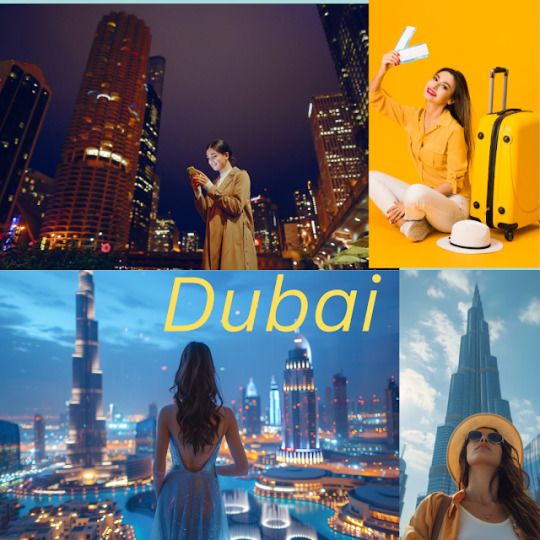
Dubai known for its ultramodern architecture, luxurious lifestyle, and vibrant culture, offers a plethora of activities and attractions for every type of traveler. Whether you’re looking for adventure, relaxation, or cultural experiences, Dubai has something for everyone. Here’s your ultimate guide to the best things to do in this dynamic city.
1. Explore Iconic Landmarks
Burj Khalifa
Description: The tallest building in the world, offering breathtaking views of the city.
Things to Do: Visit the observation decks on the 124th, 125th, and 148th floors for panoramic views.
Dubai Fountain
Description: The world's largest choreographed fountain system.
Things to Do: Watch the stunning water, light, and music shows in the evening.
Burj Al Arab
Description: The world’s only 7-star hotel, shaped like a sail.
Things to Do: Enjoy fine dining at one of its exclusive restaurants.
2. Experience Adventure and Thrill
Desert Safari
Description: A thrilling journey into the Arabian desert.
Things to Do: Dune bashing, camel riding, sandboarding, and enjoying a traditional Bedouin camp with dinner and entertainment.
Skydiving over Palm Jumeirah
Description: Experience a rush of adrenaline with a tandem skydive.
Things to Do: Soar above the iconic Palm Jumeirah for unmatched views.
Aquaventure Waterpark
Description: One of the largest waterparks in the Middle East.
Things to Do: Enjoy exciting water slides, a lazy river, and marine animal encounters.
3. Indulge in Shopping and Entertainment
The Dubai Mall
Description: The largest shopping mall in the world.
Things to Do: Shop at luxury brands, visit the Dubai Aquarium, and enjoy indoor ice skating.
Mall of the Emirates
Description: Home to a vast range of shops and entertainment options.
Things to Do: Ski at the indoor Ski Dubai, shop, and dine.
Souks of Dubai
Description: Traditional markets offering a glimpse of old Dubai.
Things to Do: Visit the Gold Souk, Spice Souk, and Textile Souk for unique shopping experiences.
4. Delve into Culture and HeritageDubai Museum
Description: Located in Al Fahidi Fort, showcasing the history and culture of Dubai.
Things to Do: Explore exhibits on traditional Emirati life and Dubai's transformation.Al Fahidi Historical Neighbourhood
Description: A preserved area with traditional wind-tower architecture.
Things to Do: Wander through narrow lanes, visit art galleries, and enjoy cultural activities.Jumeirah Mosque
Description: One of the most beautiful mosques in Dubai, open to non-Muslims.
Things to Do: Take a guided tour to learn about Islamic culture and traditions.5. Relax and UnwindJumeirah Beach
Description: A beautiful public beach with stunning views of the Burj Al Arab.
Things to Do: Sunbathe, swim, and engage in water sports.The Dubai Miracle Garden
Description: The world's largest flower garden.
Things to Do: Stroll through over 50 million blooming flowers arranged in various designs.Dubai Marina
Description: A bustling waterfront area with luxurious yachts and high-rise buildings.
Things to Do: Enjoy a leisurely walk along the Marina Walk, dine at waterfront restaurants, and take a boat tour.6. Nightlife and DiningNightclubs and Bars
Description: Dubai boasts a vibrant nightlife scene with numerous clubs and bars.
Things to Do: Visit popular spots like White Dubai, Cavalli Club, and Soho Garden.Fine Dining
Description: Dubai offers a range of high-end dining experiences.
Things to Do: Dine at world-renowned restaurants like Nobu, Zuma, and At.mosphere.ConclusionDubai is a city that never ceases to amaze with its blend of modernity and tradition. From iconic landmarks to thrilling adventures, luxurious shopping, cultural experiences, and vibrant nightlife, there’s something for everyone. Plan your trip to Dubai and immerse yourself in the wonders of this incredible city.
Tips for Booking Budget Hotels in Dubai
Dubai is known for its luxury, but it also offers a range of budget-friendly accommodations. Here are some tips to help you find the best budget hotels in Dubai without compromising on comfort or convenience.
1. Plan Ahead and Book Early
Tip: Booking your hotel well in advance can help you secure better rates and more options.
Why: Early bookings often come with discounts and promotions, especially during peak tourist seasons.
2. Use Comparison Websites
Tip: Utilize websites like Booking.com, Agoda, and Expedia to compare prices and read reviews.
Why: These platforms offer a wide range of options and user reviews to help you make an informed decision.
3. Consider Location
Tip: Choose a hotel that is close to public transportation or major attractions to save on commuting costs.
Why: Staying near metro stations or bus routes can make getting around the city more affordable and convenient.
4. Look for Hotel Deals and Packages
Tip: Check for special deals, packages, or promotions on hotel websites or travel deal sites like Groupon.
Why: Many hotels offer discounted rates, free nights, or additional perks as part of their promotional packages.
5. Stay in Less Touristy Areas
Tip: Consider staying in neighborhoods like Al Barsha, Deira, or Bur Dubai for more affordable accommodation options.
Why: These areas often have budget-friendly hotels and are still well-connected to major attractions.
6. Check for Free Amenities
Tip: Look for hotels that offer complimentary amenities like breakfast, Wi-Fi, and shuttle services.
Why: Free amenities can add significant value to your stay and reduce your overall expenses.
7. Read Reviews and Ratings
Tip: Pay attention to reviews and ratings on travel websites to ensure the quality and cleanliness of budget hotels.
Why: Honest reviews from other travelers can provide insights into the hotel's service, cleanliness, and overall experience.
8. Join Loyalty Programs
Tip: Sign up for hotel loyalty programs or travel reward programs.
Why: These programs can offer member-only discounts, points for future stays, and additional benefits.
9. Be Flexible with Dates
Tip: If possible, be flexible with your travel dates to take advantage of lower rates during off-peak times.
Why: Hotel prices can vary significantly based on demand, and traveling during off-peak seasons can result in substantial savings.
10. Consider Alternative Accommodations
Tip: Explore alternatives like hostels, guesthouses, or vacation rentals on platforms like Airbnb.
Why: These options can be more affordable and offer unique experiences compared to traditional hotels.
The Cost of Travel in Dubai: A Comprehensive Guide
Dubai, known for its luxury and opulence, can seem like an expensive destination. However, with careful planning and smart choices, you can manage your budget and still have an incredible experience. Here’s a comprehensive guide to help you understand and manage the costs of traveling in Dubai.

1. Accommodation Costs
Luxury Hotels
Cost: AED 1,000 - AED 5,000+ per night
Examples: Burj Al Arab, Atlantis The Palm
Mid-Range Hotels
Cost: AED 300 - AED 1,000 per night
Examples: Hilton Garden Inn, Holiday Inn
Budget Hotels and Hostels
Cost: AED 100 - AED 300 per night
Examples: Premier Inn, Ibis
2. Food and Dining Costs
Fine Dining
Cost: AED 300 - AED 1,000+ per meal
Examples: Nobu, Zuma
Mid-Range Restaurants
Cost: AED 100 - AED 300 per meal
Examples: Din Tai Fung, The Cheesecake Factory
Budget Eats
Cost: AED 10 - AED 50 per meal
Examples: Shawarma stands, food courts
3. Transportation Costs
Public Transportation
Cost: AED 2 - AED 7.50 per ride
Options: Metro, buses
Tip: Purchase a Nol Card for easy access and discounted fares.
Taxis
Cost: AED 12 - AED 20 for short rides, AED 60 - AED 100 for longer distances
Tip: Use apps like Careem or Uber for convenience.
Car Rentals
Cost: AED 80 - AED 300 per day
Tip: Compare prices online and book in advance for better deals.
4. Attractions and Activities Costs
Iconic Landmarks
Burj Khalifa: AED 149 - AED 600 (depending on the floor and time of visit)
Dubai Aquarium: AED 120 - AED 175
Desert Safari: AED 150 - AED 400
Theme Parks
IMG Worlds of Adventure: AED 300
Aquaventure Waterpark: AED 250 - AED 350
Cultural Experiences
Dubai Museum: AED 3
Jumeirah Mosque: AED 25
5. Shopping Costs
Luxury Malls
Cost: Variable; high-end brands are similar to prices in Europe/USA.
Examples: The Dubai Mall, Mall of the Emirates
Souks and Markets
Cost: Bargain for better prices; variable
Examples: Gold Souk, Spice Souk
6. Entertainment and Nightlife Costs
Nightclubs and Bars
Cost: AED 50 - AED 200 for entry; drinks can range from AED 30 - AED 100+
Examples: White Dubai, Cavalli Club
Shows and Performances
Cost: AED 200 - AED 500+
Examples: La Perle by Dragone, Dubai Opera
7. Miscellaneous Costs
Travel Insurance
Cost: AED 50 - AED 200 (depending on coverage and duration)
Sim Card and Internet
Cost: AED 50 - AED 200
Tip: Purchase a tourist SIM card at the airport for convenience.
Money-Saving Tips
Book in Advance: Secure better deals on flights, accommodation, and activities.
Use Public Transport: It’s efficient and much cheaper than taxis.
Dine Like a Local: Try local eateries and street food for delicious and affordable meals.
Look for Free Attractions: Visit free attractions like Jumeirah Beach, Al Fahidi Historical Neighbourhood, and Dubai Fountain shows.
Stay in Budget-Friendly Areas: Areas like Deira and Bur Dubai offer cheaper accommodations without compromising too much on convenience.
Conclusion
While Dubai is often associated with luxury, it is possible to visit on a budget. By planning ahead and making smart choices, you can enjoy the best of what this vibrant city has to offer without overspending. Whether you’re splurging on a luxury experience or seeking budget-friendly options, Dubai has something for every traveler.
#DubaiTravelGuide#ExploreDubai#BestOfDubai#DubaiBucketList#VisitDubai2024#ThingsToDoInDubai#DubaiAdventures#DubaiVacation#DiscoverDubai
0 notes